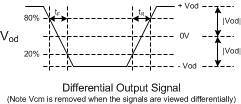DLPS048C March 2015 – June 2019 DLPC150
PRODUCTION DATA.
- 1 Features
- 2 Applications
- 3 Description
- 4 Revision History
- 5 Pin Configuration and Functions
-
6 Specifications
- 6.1 Absolute Maximum Ratings
- 6.2 ESD Ratings
- 6.3 Recommended Operating Conditions
- 6.4 Thermal Information
- 6.5 Electrical Characteristics Over Recommended Operating Conditions
- 6.6 Electrical Characteristics
- 6.7 High-Speed Sub-LVDS Electrical Characteristics
- 6.8 Low-Speed SDR Electrical Characteristics
- 6.9 System Oscillators Timing Requirements
- 6.10 Power-Up and Reset Timing Requirements
- 6.11 Parallel Interface Frame Timing Requirements
- 6.12 Parallel Interface General Timing Requirements
- 6.13 Flash Interface Timing Requirements
- 7 Parameter Measurement Information
- 8 Detailed Description
- 9 Application and Implementation
- 10Power Supply Recommendations
-
11Layout
- 11.1
Layout Guidelines
- 11.1.1 PCB Layout Guidelines For Internal Controller PLL Power
- 11.1.2 DLPC150 Reference Clock
- 11.1.3 General PCB Recommendations
- 11.1.4 General Handling Guidelines for Unused CMOS-Type Pins
- 11.1.5 Maximum Pin-to-Pin, PCB Interconnects Etch Lengths
- 11.1.6 Number of Layer Changes
- 11.1.7 Stubs
- 11.1.8 Terminations
- 11.1.9 Routing Vias
- 11.2 Layout Example
- 11.3 Thermal Considerations
- 11.1
Layout Guidelines
- 12Device and Documentation Support
- 13Mechanical, Packaging, and Orderable Information
Package Options
Mechanical Data (Package|Pins)
- ZEZ|201
Thermal pad, mechanical data (Package|Pins)
6.7 High-Speed Sub-LVDS Electrical Characteristics
over operating free-air temperature range (unless otherwise noted)| PARAMETER | MIN | TYP | MAX | UNIT | |
|---|---|---|---|---|---|
| VCM | Steady-state common mode voltage | 0.8 | 0.9 | 1 | V |
| VCM (Δpp)(1) | VCM change peak-to-peak (during switching) | 75 | mV | ||
| VCM (Δss)(1) | VCM change steady state | –10 | 10 | mV | |
| |VOD|(2) | Differential output voltage magnitude | 200 | mV | ||
| VOD (Δ) | VOD change (between logic states) | –10 | 10 | mV | |
| VOH | Single-ended output voltage high | 1 | V | ||
| VOL | Single-ended output voltage low | 0.8 | V | ||
| tR(2) | Differential output rise time | 250 | ps | ||
| tF(2) | Differential output fall time | 250 | ps | ||
| tMAX | Max switching rate | 1064 | Mbps | ||
| DCout | Output duty cycle | 45% | 50% | 55% | |
| Txterm(1) | Internal differential termination | 80 | 100 | 120 | Ω |
| Txload | 100-Ω differential PCB trace
(50-Ω transmission lines) |
0.5 | 6 | inches | |
(1) Definition of VCM changes:


(2) Note that VOD is the differential voltage swing measured across a 100-Ω termination resistance connected directly between the transmitter differential pins. |VOD| is the magnitude of this voltage swing relative to 0. Rise and fall times are defined for the differential VOD signal as follows:

